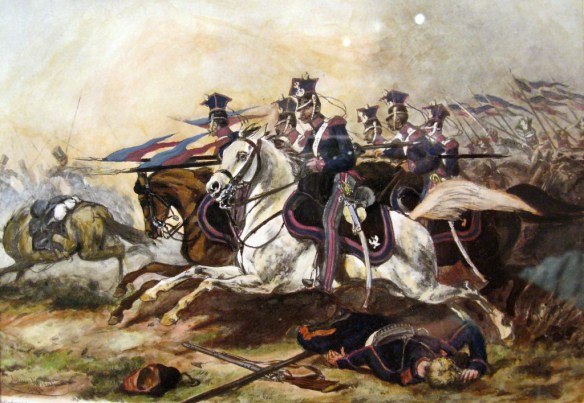
Charge of the Polish uhlans city of Poznań during November Uprising
Emilia Plater skirmishing at Šiauliai (Polish: Szawle). Painting by Wojciech Kossak, 1904
Battle of Olszynka Grochowska
PRINCIPAL COMBATANTS: Polish nationalists vs. Russia
PRINCIPAL THEATER(S): Poland
DECLARATION: Rebellion commenced on November 29, 1830.
MAJOR ISSUES AND OBJECTIVES: The rebels sought to free Poland from Russian control.
OUTCOME: The rebellion, disorganized, was ultimately crushed, and Poland was incorporated into Russia as a Russian state.
APPROXIMATE MAXIMUM NUMBER OF MEN UNDER ARMS: Nationalists, 81,000; Russians, 127,000
CASUALTIES: Nationalists, 15,000-20,000 killed; Russians, 15,000 killed
Called the November Insurrection to distinguish it from the Polish Rebellion (1863-1864), which became known as the January Insurrection, this conflict began when Russia’s czar Nicholas I (1796-1855), hoping to take advantage of the French Revolution of 1830, made plans to invade France and Belgium using the Polish army, which he supposed to be under his autocratic control. But among the many conspiratorial revolutionary groups Poland was producing at the time, there was a secret society-the National Association-formed by Polish troops with the object of coordinating an uprising against Poland’s Russian overlords. As a result of the FRENCH REVOLUTION (1830), the Polish rebels believed their efforts would receive strong support from France.
The rebellion broke out in Warsaw on November 20, 1830, when Polish officers and troops at the military academy acted on their fear of an imminent Russian takeover of the academy and, ultimately, the army itself in keeping with Nicholas’s plan. Russian cavalry companies were attacked, and an assault on the Warsaw residence of Russian grand duke Constantine (1779-1831) was mounted. Soon, almost the entire Polish army, liberated convicts, and the general Polish citizenry joined in a chaotic uprising. The result was not a revolution, but mob violence on a massive scale. After Russian authorities fled for their lives, Polish general Josef Chlopicki (1771-1854) proclaimed a revolutionary dictatorship and declared that the Russian succession to the Polish throne was at an end.
Czar Nicholas I (1796-1855) responded to the Polish rebellion by sending large numbers of troops into the country. Despite some Polish successes, the Russians advanced deep into Poland but were fought to stand at the Battle of Grochow on February 25, 1831. The Russians went into winter quarters, and during the resulting lull in combat, the Poles, never well organized, began to fight among themselves, so that when the fighting resumed in the spring the rebels were considerably weakened. The Russians triumphed at the Battle of Ostroleka on May 26, 1831, then advanced on Warsaw, which fell to them on September 8, 1831. This rebellion collapsed, and rebel leaders fled the country.
The czar now cracked down on Poland harder than ever before. Poland was not merely annexed but incorporated into Russia as a Russian state. Nicholas I was determined to stamp out any vestiges of Polish nationality. His tyranny, however, only served to intensify already powerful Polish patriotism.
Further reading: Norman Davies, God’s Playground: A History of Poland, 2 vols. (New York: Columbia University Press, 1982); O. Halecki (with additional material by A. Polonsky and Thaddeus V. Grommada), A History of Poland, new ed. (New York: Dorset Press, 1992); W. F. Reddaway, et al., eds., The Cambridge History of Poland, 2 vols. (reprint, Cambridge, UK: Cambridge University Press, 1971).